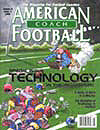AMERICAN FOOTBALL MONTHLY THE #1 RESOURCE FOR FOOTBALL COACHES
Article CategoriesAFM Magazine
|
6 Hours to 5 Minutes:The Minnesota Vikings\' philosophy on the use of computers.by: Mike Eayrs Director of Research and Development, Minnesota Vikings © More from this issue How would you like to add several hours of "free" time to your schedule each week, especially during the football season? Time to view some additional videotape, review the game plan, or maybe just get some rest. A major catalyst in freeing time for the staff of the Minnesota Vikings has been the use of computers within our football operations. We have never viewed computers as a magic bullet to solve problems. We still rely on the intelligence and creativity of our staff to make decisions and call plays. Instead, our emphasis in using computers has been to assist our staff by providing useful information and freeing our coaches from menial, redundant, and time-consuming work. For example, several years ago our linebackers coach presented a report to his players at their weekly Thursday meeting. The information origin....The full article can only be seen by subscribers.
|
|
|||||||
| HOME |
MAGAZINE |
SUBSCRIBE | ONLINE COLUMNISTS | COACHING VIDEOS |
Copyright 2025, AmericanFootballMonthly.com
All Rights Reserved





